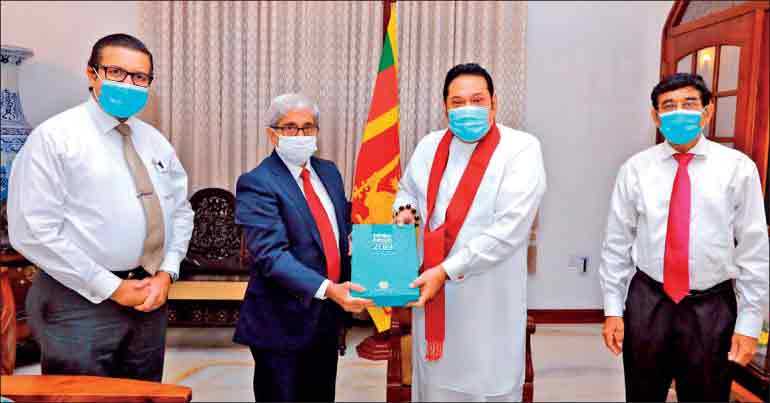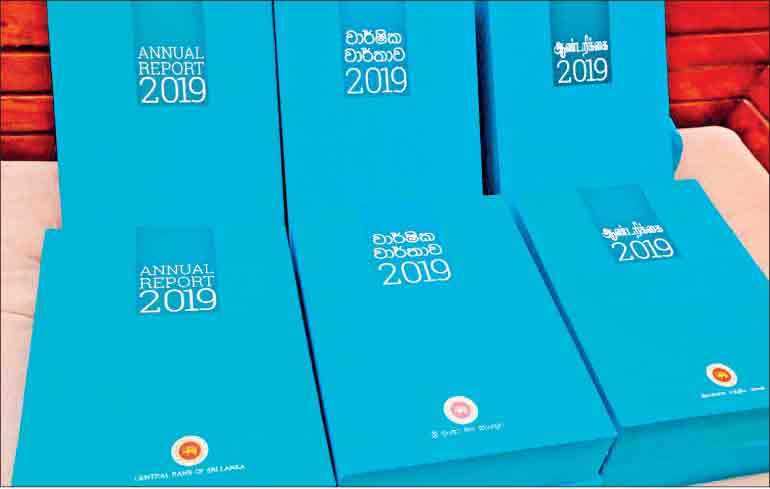Friday Apr 18, 2025
Friday Apr 18, 2025
Monday, 4 May 2020 00:42 - - {{hitsCtrl.values.hits}}

Central Bank Governor Professor W. D. Lakshman presenting the Central Bank Annual Report 2019 to Prime Minister and Finance, Economic and Policy Development Minister Mahinda Rajapaksa, Senior Deputy Governor Dr. P. Nandalal Weerasinghe and Economic Research Director Dr. Chandranath Amarasekara are also present
Aseni, the wiz kid who has developed an interest in learning everything and anything that relates to economics, has downloaded the Central Bank’s Annual Report for 2019 (available at: https://www.cbsl.gov.lk/en/publications/economic-and-financial-reports/annual-reports/annual-report-2019). She has found, to her horror, that she couldn’t make head or tail out of it, despite some previous training in economics she had undergone. She sought the help of her Grandfather, Sarath Mahattaya, an ex-officer of the Ministry of Finance, to understand the key message delivered in the report. It led to a very fruitful and informative dialogue between the two
Aseni: Grandpa, I believe that you had time to read through the latest Annual Report issued by the Central Bank for 2019. I found that the language and the terms it has used are beyond the comprehension of an ordinary folk like me. Can you help me to learn the key message it has delivered?
Sarath: Naturally, you may not be able to understand it without the support of someone who can explain in layman’s language the subtle arguments made in the report. That is because it is written by professional economists for use by professional economists. They use a scholarly language using the minimum number of words to put their views across to prospective readers. Therefore, like the subsequent Buddhist scholars had to write commentaries known as Atuvaa or Teeka to explain what the Buddha had meant by each word in his discourses, somebody has to write a commentary on the Annual Report to make it comprehensible by ordinary readers.
A: Has the Annual Report has been so in the past too? Or, is it just a new development?
S: Yes, it has been so ever since the Central Bank had been established in 1950. But you can’t blame the Central Bank for it. If you look at the reports issued by institutions like IMF, World Bank, ADB or other global central banks, you will find they aren’t dissimilar to what our central bank has issued. It’s a common global culture and exclusive to those who are in the knowing and not unknowing. You should aspire to join this club. Once you do so, you’ll start enjoying these reports.
A: Thanks Grandpa. I recall you once telling me that it is a misnomer to call this report the Central Bank Annual Report. I’ve forgotten your reasons now. What did you mean by it?
S: This is peculiar to the situation in Sri Lanka because in law there isn’t an institution called the Central Bank. That’s because by law what has been established isn’t the central bank, but a body of people called the Monetary Board. The Central Bank which is so familiar to us is owned by this Monetary Board. Hence, it doesn’t have a legal existence of its own. Therefore, the report is the Report of the Monetary Board submitted to the Minister of Finance to be tabled in Parliament. It gives an account of the state of the economy, the policies made by the Board, why the Board has made those policies and most importantly how the Minister should change his policies to be compatible with the policies of the Board. The tabling of the report in Parliament serves two purposes. One is that the legislators get an opportunity to master it and, if necessary, have a debate in Parliament. The other is that it then becomes a public document and people like us who are outside the Central Bank will have access to it. But throughout its history, there hasn’t been a single instance of a Parliamentary debate on the Monetary Board’s report. This is understandable, like you, the legislators are unable to lead a productive debate without a special tutorial class for them.
A: If it’s a report of the Monetary Board, does it mean that the Board writes it?
S: No. The Board is made up of people, except its Chairman, the Governor, who are not full-timers there. Hence, the report is the product of its professional staff led by the Bank’s Director of Economic Research. They work day and night in the first few months of the year to produce it. Those economists attached to the department have to write, rewrite and re-rewrite the report many times in the light of the comments made by the senior officers of the Bank before it’s forwarded to the Monetary Board for its adoption. Therefore, though the final responsibility for the content of the report lies with the Board, it basically conveys the hard-core economic wisdom held by all those within the Central Bank.
A: I’ve observed that the report in 2019 has contained a lot of additional features like the use of visual art in the form of infographics to illustrate its points. Though the text is in alien language, these artworks are comprehensible by ordinary readers. Isn’t it a good point Grandpa?
S: Yes, this is a new feature introduced to the Annual Report in the previous year. It to some extent mitigates the ordinary readers’ disability. I’ve noted two important observations about the Annual Reports in general. One is that every succeeding year, the staff has been able to make a lot of improvements to the report. This is a testimony to what I’d always maintained that your successors are in every respect better than you. They’re tech savvy, creative and ever-ready to use their knowledge to better the world if they’re given a chance. In that respect, this year’s report is much better than the previous year’s one. I think all those who have contributed to it deserve credit for it.
The other observation I’ve made is that this year’s report has been prepared by these officers in trying conditions at great cost to the health of not only themselves but also their close family members. But one good thing about the staff of the Central Bank is that they always become more creative when the situation is unfriendly to them. This year’s annual report evidences this amply. One other occasion I can recall is that when the Bank was virtually destroyed by the LTTE bomb in 1996. At that time, the Bank’s research staff, temporarily relocated in makeshift offices in the under-equipped staff training college in Rajagiriya, changed the format of the annual report for 1995 and introduced the system of box articles to it to keep the readers educated on important issues of the day. This special quality of the central bank staff in which they take challenges as opportunities should be emulated by young people like you, Aseni!
A: That’s wonderful, Grandpa. But what’s the key message in the annual report for 2019?
S: To learn of the message, you don’t have to read the entire report. Just read Chapter 1 of the report which is like an executive summary. It’s the prerogative of the incumbent director of economic research to pen it after all other chapters in the report have been completed by the respective divisional economists. It’s the signature mark of the director since he tries to present his unique understanding of the economy vis-à-vis the underlying global trends. This year’s Chapter 1 is specifically important because it has been written at a time when the country has been hit by three fears. These three fears are so ominous that the much talked-about three fears in City of Visala during the Buddha’s time could be said to be just a child’s play. According to scriptures, the Buddha had removed all the three fears just by chanting one Sutta. But the present fears cannot be eradicated by such spiritual interventions.
A: What are those fears, Grandpa?
S: The first fear is that the economy had been slowing down since around 2013 pushing down the situ to its worst portending an ominous future for the country. It has worsened the exchange rate, external payments and the country’s ability to repay debt. The second fear is the man-made political instability making the government sector totally fragile without a proper budget. Its inefficiency is satanically rubbing on the efficiency of the central bank. The third fear was totally unexpected, the COVID-19 pandemic that hit not only Sri Lanka but also the whole world. Its fearful fallout is that people have begun to mistrust the markets, global economy, private initiatives, wisdom of economic policy-makers, and collaborative and cooperative action. Even the disgruntled heads of state have opined that the world should seek to establish a new world order which advocates for self-sufficiency and isolated existence. True that markets and the global economy have been functioning below what people had been used to, but it is not a failure of these two institutions per se. It’s due to the interventionist action of the national governments to prevent a speedy spread of COVID-19 justified by necessity and catering to the fears of people. The incumbent director has argued throughout Chapter 1 for the improvement of markets and removing their inefficiency by reforming the economic structure of the country. This’s a rare foresight in my view.
A: But that chapter too has been written in scholarly language and beyond my understanding. How should I set about in understanding what he’s said in that chapter?
S: It’s not a big deal if you can understand what he has said in the first two paras in italics in Chapter 1. All he’s to say has been compacted in technical language in these two paras. But you’ve to write a separate book by way of a commentary to make it accessible to ordinary readers. Let’s try it.
A: Unlike the previous annual reports, he’s not given a clean certificate to those who had been in power. What does he mean when he says that the economic performance was dismal, correction of the external imbalance was only to some extent and the inflation was largely muted?
S: That opening sentence has provided the full story from a different angle. This’s all evidence based. The economy, measured in the growth of real goods and services, started its downward move in 2013. It became worse in every passing year. The governments in power before 2015 and during 2015 to 2019 had done very little to reverse this trend. Therefore, it’s quite correct to say that the economic growth of 2.3% in 2019 was dismal. This’s frustrating because the Bank had predicted earlier the economy to grow by 4% in 2019. What this meant was that if we produce only coconuts, for example, the expectation had been to increase the coconut production from 100 to 104 coconuts. But the actual production was 102 coconuts and a little more.
It’s dismal from another point. If the number of mouths in 2018 was 100, each person had got, on average, a coconut to eat. But the number of mouths had increased close to 101 in 2019. But each person now gets one coconut and a dismally insignificant portion as his share. That doesn’t increase his well-being at all.
The other two qualifications he had made also represents this dismal position in a different manner. When he says that the correction to the external imbalance was successful only to some extent, and inflation has been only muted, the ailment in the economy is pretty much there in a subdued condition. At any time, both can be re-ignited and if that happens, the exchange rate would further depreciate and inflation can raise its ugly head. Thus, the policies to tackle them should be pursued unabated. In fact, the muted inflation was the result of the low demand for goods and services.
A: He’s said that the monetary policy space and the banking sector capital space had enabled the central bank to help the government to ease the condition on the people affected by COVID-19. What does this space mean?
S: The space relating to a policy means the freedom which a policy-maker gets to move forward in an emergency without compromising the attainments already made. The central bank had maintained inflation within its targeted bounds in the past few years. Therefore, any supportive policy leading to an increase in money supply could be accommodated just by allowing inflation to rise only by a bit. Similarly, under the prudential regulatory mechanism being introduced by the central bank, banks had increased their capital levels to a high amount by allocating more funds to build the capital stock when the going was good. This strategy known as the capital conservation buffer that allows banks to take extra measures to protect the customers without allowing capital to decline in the case of an extraordinary situation. This space is another freedom which commercial banks as affected institutions and the central bank as the regulator has got. Both freedoms have enabled the central bank to allow money supply to increase without causing inflation in the immediately following period and promote bank lending without eating up the capital levels of banks.
In contrast, though the report has not mentioned it explicitly, the government doesn’t have this space. With low revenue, ballooning expenditure levels, rising debt repayment obligations and rising budget deficits, it can’t provide any relief to people whom the report has called stakeholders. What this means is that the full burden of rescuing the economy during the COVID-19 pandemic devolves on the central bank.
A: The report has spoken of a long-list of ‘what-to-do’ to attain prosperity in the medium to long run, especially measures for facilitating innovation and improving factor productivity and efficiency. These reforms are not pleasant and therefore would worsen the conditions of mainly the low-income people. Why can’t we do without such painful reforms?
S: Sri Lanka has just got itself the status of a higher middle-income country. The next point is to become a high-income country or a rich country. This higher middle-income status has become a curse for many countries in the world, as the report has explained in a box article, because they haven’t been able to cross the threshold of a rich country. This ailment is known as the middle-income trap. The central bank wants to beat the middle-income trap and become a rich country within the shortest time possible. But to do that, the economy should be restructured to produce more with less, a condition known as productivity improvement. For that, markets have to be developed. That’s why the report has come up with a long what-to-do list.
Sri Lanka’s growth has come in the past four decades mainly by adding more capital and not by improving the knowledge base of people. This was the practice adopted by Singapore, South Korea, Taiwan and Hong Kong in the initial period of economic advancement. However, after they realised that old capital can’t take them to richness, they introduced smart capital on one side and human knowledge on the other. This is the strategy which the annual report has emphasised.
Aseni, a very simple example from our kitchen will explain this point to you. You may recall your Grandma was scraping coconut in the good old days by using a traditional coconut scraper known as ‘Hiramanaya’. It took a long time and much of her energy to scrape a coconut. Then, your Dad brought a rotating scraper with ball-bearings to rotate it easily and a scraper with a number of blades attached to it. Your Mom scraped coconut in half the time your Grandma did with much less energy spent on it. Thus, the new rotating scraper has improved her productivity a lot. Then, your Dad recently brought another coconut scraper driven by an electric motor and your Mom was able to scrape a coconut in less than half the time she spent on the rotating scraper. You can see that improved capital and improved knowledge increases both productivity and efficiency. This’s the key message the annual report has given us. It’s specifically important because in the COVID-19 pandemic there’s a growing number of people who argue that we should go back to Grandma’s old coconut scraper.
A: Thanks, Grandpa, I now know how to read and understand the annual report for 2019.
(The writer, a former Deputy Governor of the Central Bank of Sri Lanka, can be reached at [email protected].)

The Central Bank Annual Report 2019 has been prepared by Central Bank officers in trying conditions at great cost to their health and that of their close family members
Discover Kapruka, the leading online shopping platform in Sri Lanka, where you can conveniently send Gifts and Flowers to your loved ones for any event including Valentine ’s Day. Explore a wide range of popular Shopping Categories on Kapruka, including Toys, Groceries, Electronics, Birthday Cakes, Fruits, Chocolates, Flower Bouquets, Clothing, Watches, Lingerie, Gift Sets and Jewellery. Also if you’re interested in selling with Kapruka, Partner Central by Kapruka is the best solution to start with. Moreover, through Kapruka Global Shop, you can also enjoy the convenience of purchasing products from renowned platforms like Amazon and eBay and have them delivered to Sri Lanka.
Discover Kapruka, the leading online shopping platform in Sri Lanka, where you can conveniently send Gifts and Flowers to your loved ones for any event including Valentine ’s Day. Explore a wide range of popular Shopping Categories on Kapruka, including Toys, Groceries, Electronics, Birthday Cakes, Fruits, Chocolates, Flower Bouquets, Clothing, Watches, Lingerie, Gift Sets and Jewellery. Also if you’re interested in selling with Kapruka, Partner Central by Kapruka is the best solution to start with. Moreover, through Kapruka Global Shop, you can also enjoy the convenience of purchasing products from renowned platforms like Amazon and eBay and have them delivered to Sri Lanka.